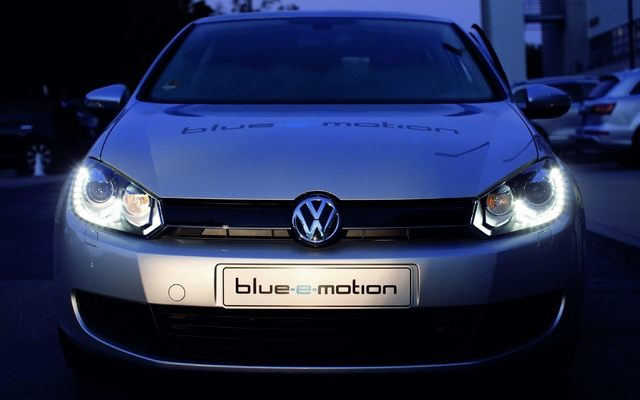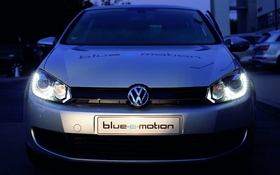Volkswagen Blue-e-motion: On the electric bandwagon!
A few weeks ago, Car Guide Web journalists had the chance to get behind the wheel of the upcoming electric Golf, dubbed the Blue-e-motion.
These days, people are paying less attention to hybrid vehicles, as all-electrics are being touted as the solution to all of the world’s problems. The Volkswagen Golf Blue-e-motion has hopped onto the bandwagon, joining the Nissan Leaf, Chevrolet Volt, Ford Focus EV, smart ED and many others.
In practical terms, the electric Golf is not very different from the regular version. If our test vehicle hadn’t been proudly sporting some Blue-e-motion stickers, no one would have ever suspected that there was anything different about it. Though people with a sharp eye might have noticed that it didn’t have a muffler.
The Golf Blue-e-motion is powered by an 85 kW electric engine (114 horsepower) that delivers a maximum of 199 lbs-ft of torque. Its lithium-ion battery can store up to 26.5 kWh. Its range is 150 km and, of course, brake energy is recovered to improve this range. Max speed is 137 km/hr and, according to Volkswagen, the vehicle can go from 0-100 km/hr in 11.8 seconds.
Batteries here, there and everywhere
But let’s get back to the battery. It is made up of 180 cells clustered into 30 modules. These are stored under the trunk floor (thereby sending the spare tire to accessory heaven under the rear seat and between the two front seats). This also frees up a space for the exhaust system (it’s basically a tunnel that runs down the centre of the vehicle). A separate ventilation system ensures that the battery temperature remains constant and perfect. Adding approximately 200 kg to the Golf, these batteries lower the vehicle’s centre of gravity and therefore should make for better road handling. The handouts produced by Volkswagen claim that the charging plug is under the VW insignia in the centre of the grille. However, the one in our test vehicle was located under the "gas tank" flap.
More changes were made to the inside than the outside. The gauge that normally indicates rpm has been replaced by a unit that tells you how many kW the accelerator is drawing. A smaller gauge inside the bigger one lets you know what the remaining driving range is. On the right is a speedometer and below is an indicator showing the battery charge level.
A real engine brake!
Between these two circles is a small rectangular screen that, according to Volkswagen’s press document, allows the driver to pre-set the battery charge function. There are four modes: D, D1, D2 and D3. For example, in D mode, the car can slow down on its own when you ease off the accelerator, without help from the engine brake. At the other end of the spectrum, in D3 mode, as much energy as possible is recovered and transferred to the battery, and braking is a lot more noticeable. However, our vehicle did not have this system (either that or the engineers on hand forgot to point it out...). But it was possible to put the gear shift into "B" (Brake). Having tried this mode that significantly increases the engine brake, let me tell you, it brakes like hell! All you have to do is think of braking and the vehicle slows down! In the city, it’s an excellent way to recharge the battery while reducing wear on the brake calipers.
Meanwhile, a button on the console lets you choose between Comfort, Autonomy and Dynamic Modes, which influence the power of the electric engine, climate control, maximum speed and energy recovery. Aside from that, it’s pretty much the same as the "regular" Golf. But before I finish, I’ll point out that the Blue-e-motion’s electric power system could easily make its way into the brand’s other models.
Hard to say…
After driving a few kilometres through the city, we really started to appreciate the vehicle’s ultra quiet ride. Its accelerations seemed pretty much on par with the 2.5 version, though I didn’t get the chance to actually do any time tests. Like all VWs, the steering precision and feedback is terrific. However, the suspension seemed a little hard, but since we were in L.A. it was a little hard to judge. Back home with all our potholes, it might be another story. As for road handling, once again it’s hard to say. Taking a corner at a higher speed resulted in some more pronounced weight transfer, which makes sense given the car’s added weight. Or maybe the run-flat tires had something to do with it...
The electric Golf will be available in 2013, just after the launch of the Up!, an all-electric urban car. As this article was being written (January 2011), electric vehicles are capturing headlines, but you still don’t see any on the road, other than the odd test unit. And though several are slated for release, I doubt they’ll be widespread by 2013. And that’s taking into account sky-high gas prices. I think Volkswagen is going to have a hard time convincing drivers to buy its electric Golf when the TDI is an outstanding example of fuel economy and autonomy, plus it’s reliable and has a great resale value. But as a promotional tool, the Golf Blue-e-motion, like all other electric cars, is perfect. The proof? People are talking about it!












